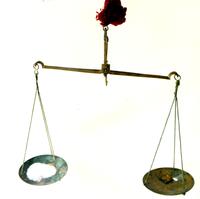
Medical and other weighing machines
Website for the Virtual Museum
Home
Coming meetings
Past meetings
About the Society
Main Galleries
Medicine
Surgery
Anaesthesia
X-rays
Hospitals,other organisations
Individuals of note
Small Galleries
Ethnic medicine
- Aboriginal
- Chinese
- Mediterran
Apothecary Scales and Weight Systems Such As Avoirdupois and Troy.
Acknowledgements:
We are most grateful to Dr. Luther C. Hoff, who kindly donated the set of the apothecary scales owned by his father, Pastor Bernhart Friedrich Hoff, at an Aboriginal mission at Koonibba during the 1920's. As a Lutheran missionary Pastor Hoff wrote a dictionary translating common Aboriginal words into English and provided most important artefacts for the Museum of South Australia. He also helped the local and visiting doctors by preparing simple medical prescriptions for his community.
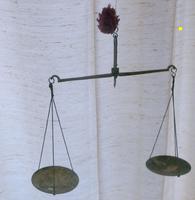 A set of scales used Dr. Hoff's father, who used the apothecary weight system to make mixtures and simple analgesics.
A set of scales used Dr. Hoff's father, who used the apothecary weight system to make mixtures and simple analgesics.The apothecary system is similar to the Troy system of weight measurement. The former is commonly used to weigh medicinal drugs, while the Troy weights are used to weigh coins and metals, such as gold and silver. They differ from the avoirdupois which is used for more substantial weights. The avoirdupois measures have 16 ounces in a pound, the Apothecary and Troy system (named after the French town of Troyes) have 12 ounces in a pound, and use lighter weights, such as scruples and grains.
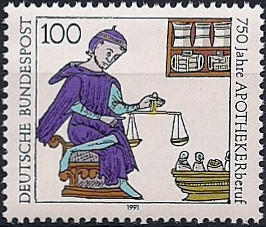 A German stamp commemorating 750 years of apothecary scales.
A German stamp commemorating 750 years of apothecary scales.
Weight
(symbol)pound
( ℔ )ounce
( ℥ )drachm
( ʒ )scruple
( ℈ )grain
( gr. )1 12 96 288 5,760 1 8 24 480 1 3 60 1 20 metric 373 g 31.1 g 3.89 g 1.296 g 64.8 mg Apothecary and Troy weights, and their metric equivalents.
The OED (Oxford English Dictionary) has several entries for scruples. Relevant to measurements, it refers to scruples as a being derived from "scrupulus" (Latin for "a small sharp stone"), a Roman unit of weight, 20 grains, 1/3rd of a drachma. Cicero referred to "anxiety and un-easiness".
Other definitions include one twenty-fourth of an hour (2 minutes and 30 seconds); one twenty-fourth of an uncia (Latin for "one-twelfth part", and the root of "ounce" and "inch") of a jugerum (a common Roman area of land, 240 foot long and 120 wide, 28,800 square feet) of land, thus a 10 foot square area (or 100 square feet); a very small amount, and moral or ethical standard.
Infusion of Dandelion, &c. ℞ Infusi Taraxaci, f℥iv. 4 fluid ounces of dandelion infusion. Extracti Taraxaci, ʒij. 2 drachms of dandelion extract. Sodæ Carbonatis, ʒiij. 3 drachms of sodium carbonate. Potassæ Tartratis, ʒiij. 3 drachms of potassium tartrate. Tincturæ Rhei, fʒiij. 3 fluid drachms of rhubarb tincture. ———— Hyoscyami, gtt. xx. 20 drops of henbane tincture. Fiat mistura. Signa.—One third part to be taken three times a day. In dropsical and visceral affections. Make mixture. Write: "One third part to be taken three times a day. In dropsical and visceral affections.". A simple diuretic prescription using apothecary signs and weights. Mixtures were more common.
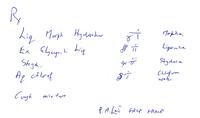 Dr. Peter Last recalls writing such prescriptions in 1950's. He kindly wrote a prescription for a cough mixture.
Dr. Peter Last recalls writing such prescriptions in 1950's. He kindly wrote a prescription for a cough mixture.
Appendix
The measures of mass and volume were most important to early merchants and tradesmen. The early measures had actual grains of wheat and pebbles for small weights. Larger weights used stones and pounds.
Small weight differences did exist between regions or nations, but could be accepted. The merchants dealing with gold, coins and other precious substances were faced with unexpected difficulties. Coins were often "shaved" at their periphery, or treated with nitric acid to reduce their weight. The "milling" of the coin edges removed some of the problem. In addition there were forgeries. These usually involved adding a less valuable metal to gold or silver. Therefore accurate weighing was important to detect any abnormality.
Pharmacists faced similar problems, such as need to avoid over or under-dosing.
In the 1940-60's most countries changed to the metric system, and the differences between countries and local regions were removed.
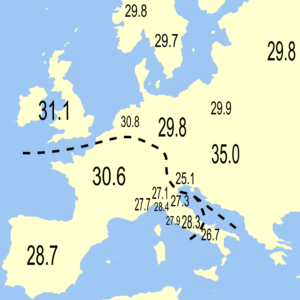 Regional variation in the weight (in grammes) of ounces in 19th and early 20th century Europe.
Regional variation in the weight (in grammes) of ounces in 19th and early 20th century Europe.The above picture shows some of the differences between the values of weights of an apothecary ounce (in grammes) in various European countries. Much to the relief of pharmacists, numismatists and chemists, metrication produced the needed standards and removed international differences.
-o0o-




